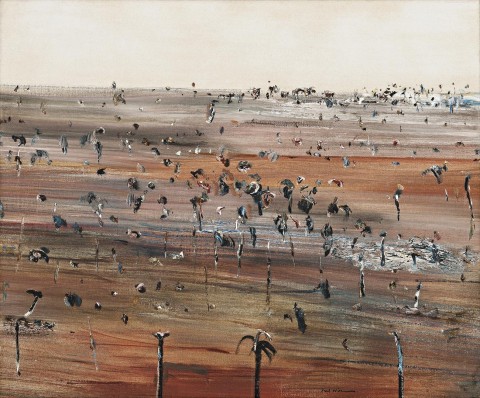SILVER LANDSCAPE, 1968
FRED WILLIAMS
oil on canvas
88.5 x 106.5 cm
signed lower right: Fred Williams
artist's label attached verso with title, date, medium, dimensions and artist's name
Rudy Komon Gallery, Sydney
Private collection, Queensland, acquired from the above in November 1969
Deutscher and Hackett, Melbourne, 9 May 2007, lot 24
Private collection, Sydney
We are grateful to Lyn Williams for her assistance with this catalogue entry.
Bushfires are part of Australian life, art and history, two outstanding early examples of threatening infernos being Eugene von Guérard’s Bush Fire Between Mount Elephant and Timboon 1857, 1859, in the collection of the Art Gallery of Ballarat, Victoria and John Longstaff’s Gippsland, Sunday Night, February 20th, 1898, 1898, in the National Gallery of Victoria, Melbourne. Fred Williams once lived at Upwey in the Dandenong Ranges, southeast of Melbourne. Its mountainous topography and highly inflammable forests of eucalypts and natural litter made it one of the most dangerous bushfire areas in the world. The summer fires of 1968, which threatened Williams’ home, had a deep effect on his art. It resulted in the fire series on which he spent much of that year. A new perception of the landscape emerged, Williams again leading the way in which we see and understand our natural environment.
The series consists of three groups – the approach, as in the ominous column of smoke in Approaching Bushfire, 1968, a gouache in the National Gallery of Victoria; the aftermath, the wild beauty of the transformed landscape seen in a trio of gouaches, After Bushfire 1-3, 1968, also in the National Gallery of Victoria; followed by the miracle of regeneration in the oil painting Burnt Ferns, 1969 in the Queensland Art Gallery, Brisbane. Fascinated by the dramatic changes, Williams first captured the striking beauty of destruction in numerous gouaches painted directly from the motif, followed by oil paintings and prints. In Silver Landscape, 1968, our painting on offer, Williams bridges the gap between devastation and new life with a new brilliance. By transforming the blackened scene into one of silvery beauty, Williams mirrored the miracle of recreation. Undergrowth has gone. The land is laid bare. Yet, the bold panorama of horizontal strokes and undulating earth entices. Richly dark in parts, ochre blends with silver in others. There is a new openness and depth, a sweeping grandeur. This spaciousness is shared with other major paintings in the series, especially the two versions of Burnt Landscape, 1968 in private collections, enriched by their unique blend of primordial appeal and regeneration.1 Patrick McCaughey wrote of one: ‘Rarely before had [Williams] made distance so integral a part of the conception’.2 The vertical accent of tree trunks in Silver Landscape, nevertheless, provides the classical balance, echoed in its colours. Some trees are gaunt. Others are touched with regrowth. Seen from a high viewpoint, even the splendour of its breadth allows for those characteristically enriched surfaces of textured crusts and swirls of impasto in a veritable feast of paint. Scrubbiness has returned. The singularity of Williams’ vision, combined with his deep understanding of art and technique, gives his paintings the appeal and authority through which our understanding and appreciation of the Australian landscape continues to be renewed and extended. So it is with Silver Landscape.
1. Both versions of Burnt Landscape, 1968 are illustrated in Mollison, J., A Singular Vision: The Art of Fred Williams, Australian National Gallery, Canberra, 1989, p. 126, and McCaughey, P., Fred Williams, Bay Books, Sydney 1980, plate 109, respectively.
2. McCaughey, ibid, p. 203
DAVID THOMAS
